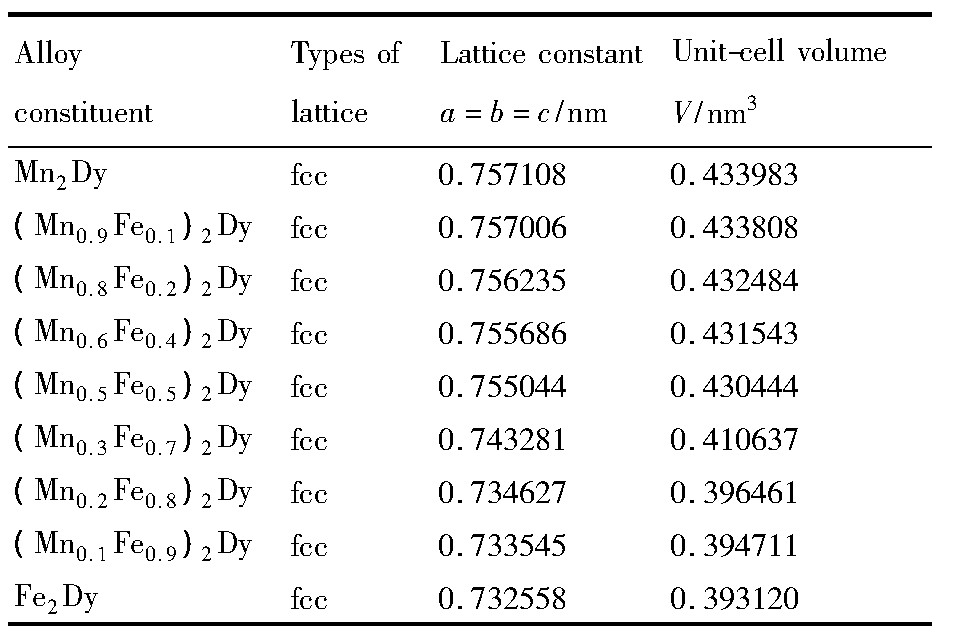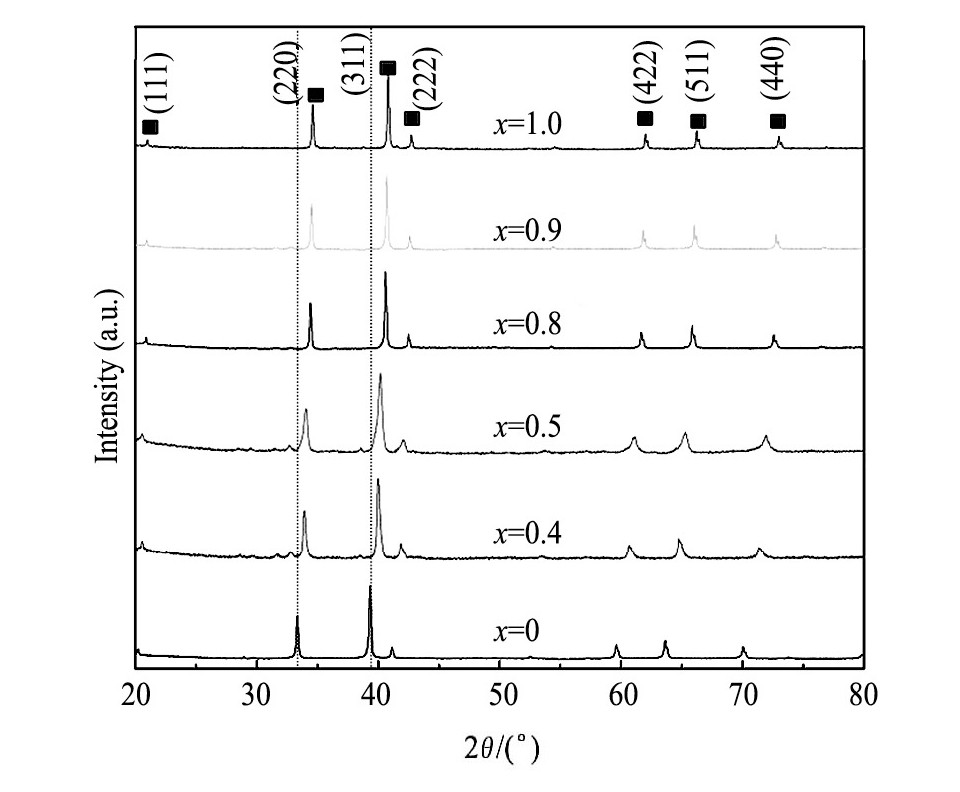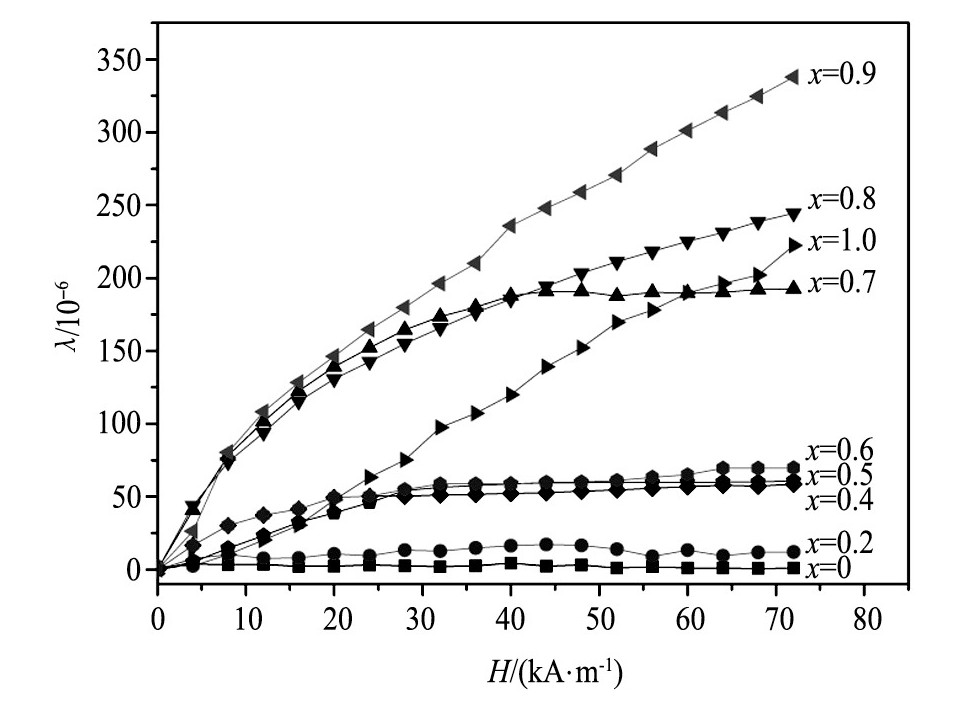网络首发时间: 2016-11-11 13:57
Fe替代Mn对Mn2Dy化合物的结构和磁相关性能的影响
桂林电子科技大学材料科学与工程学院
桂林电子科技大学广西信息材料重点实验室
摘 要:
采用真空氩弧熔炼的方法制备了 (Mn1-xFex) 2Dy (x=01.0) 系列样品, 在800℃下进行热处理10 h, 利用X射线衍射仪 (XRD) 、综合物性测量系统 (PPMS) 、电阻应变片法等测试方法系统研究了不同Fe替代量对Mn2Dy化合物的结构演变、磁性能和磁致伸缩性能的影响。研究结果表明, Mn2Dy化合物具有典型的Mg Cu2 (C15型) 面心立方 (fcc) 晶体结构, 随着Fe替代量x的增加, (Mn1-xFex) 2Dy化合物的晶胞体积和晶胞参数a, b, c逐渐减小, 但始终保持fcc晶体结构不变;Mn2Dy化合物为反铁磁体, 当Fe替代量x>0.5时, 该化合物开始由反铁磁性向铁磁性转变, 饱和磁化强度 (Ms) 可在6.080.0 Am2·kg-1之间调控;反铁磁Mn2Dy几乎不显示磁致伸缩性能, 随着Fe替代量的增加, 磁致伸缩系数 (λ) 逐步提高且灵敏度越来越高, 当x=0.9时在72 k A·m-1外场下λ最高可以达到350×10-6。机制探讨表明, 铁磁性的Fe元素替代Mn后改变了Mn2Dy化合物的磁晶各向异性与磁性, 从而影响了磁致伸缩性能。
关键词:
中图分类号: TB381
作者简介:郭永斌 (1991-) , 男, 山东临沂人, 硕士研究生, 研究方向:磁性材料;E-mail:1097467234@qq.com;;马垒, 副教授;电话:0773-2291680;E-mail:malei@guet.edu.cn;
收稿日期:2016-09-21
基金:国家自然科学基金项目 (51461012);桂林电子科技大学-中铝广西有色金源稀土有限公司研究生联合培养基地专项经费资助项目 (20160513-12-Z);广西信息材料重点实验室项目 (161011-Z) 资助;
Structure and Magnetic Properties of (Mn1-xFex) 2Dy Compounds with Fe Dopping
Guo Yongbin Ma Lei Zhao Shiqian Zhou Liang Liu Tao Wang Dao
School of Material Science and Engineering, Guilin University of Electronic Technology
Guangxi Key laboratory of Information Materials, Guilin University of Electronic Technology
Abstract:
The (Mn1-xFex) 2Dy (x = 0 ~ 1. 0) samples were prepared by vacuum argon arc melting method, then annealed at 800 ℃for 10 h, and the effects of different Fe substitutions on the structural evolution, magnetic properties and magnetostriction performance of Mn2Dy compounds were investigated by X-ray diffraction (XRD) , physical property measurement system (PPMS) and resistance strain gage method. The results showed that the crystal structure of Mn2Dy compound was Mg Cu2 (C15 type) , which was face-centered cubic (fcc) phase. The unit cell volumes and lattice parameter a, b, c of (Mn1-xFex) 2Dy compounds decreased gradually with the increase of x, but crystal structure kept the fcc structure. Mn2Dy compound was antiferromagnets, nevertheless, the magnetic type of (Mn1-xFex) 2Dy compounds began to transform from antiferromagnetism to ferromagnetism when x > 0. 5, and the saturation magnetization (Ms) could be controlled between ~ 6. 0 ~ 80. 0 Am2·kg-1. The antiferromagnetic Mn2Dy showed almost no magnetostriction performance. With the increase of Fe-substitution, the magnetostriction coefficient (λ) increased gradually and the sensitivity was improved. When x = 0. 9, the maximum of λ could reach 350 × 10-6 at 72 k A·m-1 external magnetic field. The mechanism analysis showed that the substitution of Fe changed the magnetocrystalline anisotropy and magnetic properties of Mn2Dy compound, and then affected the magnetostriction performance.
Keyword:
Mn2Dy; Fe2Dy; magnetostriction; magnetic properties;
Received: 2016-09-21
自从发现物质的磁致伸缩效应后, 人们就一直想利用这一物理效应来制造有用的功能器件与设备。为此人们研究和发展了一系列磁致伸缩材料, 主要有3大类:即:具有磁致伸缩性能的金属与合金, 如镍基合金 (如Ni, Ni-Co, Ni-Co-Cr等) 和铁基合金 (如Fe-Ni, Fe-Al, Fe-Co-V等) 和铁氧体磁致伸缩材料 (如Ni-Co-Cu铁氧体材料等) 。以上称为传统磁致伸缩材料, 其磁致伸缩系数 (λ) 值过小, 它们没有得到推广应用, 后来人们发现了稀土金属间化合物磁致伸缩材料, 主要是以 (Tb, Dy) Fe2化合物为基体的合金, 其中Tb0.3Dy0.7Fe1.95材料的λ达到1500×10-6~2000×10-6, 比之前传统磁致伸缩材料的λ大1~2个数量级, 被称为超磁致伸缩材料Terfenol-D, 其在制动器、执行器和传感器等领域得到了广泛的关注和研究[1,2]。然而由于Terfenol-D合金具有脆性大、不易加工、稀土使用量大、成本高和高磁饱和场等缺点而受到限制[3]。有关元素替代对磁性能和磁致伸缩性能的影响已经在R (Fe1-xTx) 2 (T=Co, Ni, Mn, Al等) 伪二元Laves相合金中得到了广泛的研究[4,5]。研究表明, 室温下如果在 (Tb, Dy) Fe2中用适量的Mn取代Fe, 会通过改变其磁晶各向异性来提高其磁致伸缩性能和降低自旋重取向温度[6,7,8,9]。Terfenol-D磁致伸缩材料的原型化合物是Fe2Dy, 对Fe位或RE位的取代和掺杂已有较多的报道[5,10,11,12], 其中Mn的添加主要是替代Fe的原子位置, 替代量均小于30%, Mn和Fe的最佳比例为1∶9[13], 而高Mn含量的Fe2Dy化合物至今没有报道。另外, 通过对Fe-Mn-Dy相关的二元和三元相图和化合物的调研发现, Mn2Dy与Fe2Dy形成无限互溶的固溶体, Mn2Dy和Fe2Dy具有相似的晶体结构[14,15], 具有共同的Laves相, 空间群都为Fd3m, 遗憾的是, 到目前为止鲜有对Mn2Dy化合物的磁致伸缩性能的研究。
本文主要研究了 (Mn1-xFex) 2Dy (x=0~1.0) 系列化合物的结构和磁性能, 通过Fe逐渐替代Mn直至全部取代, 着重研究了Fe取代Mn后Mn2Dy化合物的结构和磁性能演变, 以及磁致伸缩性能的变化。
1 实验
本实验中Fe, Dy的纯度均高于99.99%, Mn的纯度高于99.95%。采用WK-Ⅱ型非自耗真空氩弧熔炼法合成, 为保证成分的均匀性, 熔炼过程中反复熔炼3~4次, 样品损失率小于0.5% (质量分数) 。由于Mn的挥发量较大, 因此在配样时多增加3%。将熔炼好的纽扣状样品密封在200 mbar氩气的石英管中, 在800℃的温度下保温10 h, 再放入水中冷却至室温。将得到的样品在丙酮的保护下磨成粉末, 然后采用荷兰PANalytical公司生产的Empyrean PIXcel3D型X射线多晶粉末衍射仪 (XRD, U/I=45 k V/40 m A, Cu靶Kα1辐射, 波长λ=1.54056 nm) 在室温下对样品进行物相测定。利用线切割制备尺寸为6.0 mm×5.0 mm×0.5mm的待测样品, 采用电阻应变法测量试样在0~72 k A·m-1外场下的λ值, 重复测量次数不少于3次。用美国Quantum Design公司生产的Ever CoolⅡ型综合物性测量系统 (PPMS-9) 中的VSM选件测量样品的磁性能, 测量温度为300 K。
2 结果与讨论
2.1 相结构分析
Mn2Dy和Fe2Dy化合物具有典型的Mg Cu2 (C15型) 面心立方晶体结构, 空间群均为Fd3m[3]。图1为部分 (Mn1-xFex) 2Dy (x=0, 0.4, 0.5, 0.8, 0.9, 1.0) 系列化合物在800℃退火10 h的XRD谱线。由图1中衍射峰的变化可以看出Fe原子的加入, 未改变其晶格类型, 替代量x从0增加到1.0的过程中, 仍保持Mg Cu2型立方Laves相结构, 在20°~80°范围内, (111) , (220) , (311) , (222) , (422) , (511) 及 (400) 均为其特征峰。可以明显地看出, 随着Fe原子逐渐替代Mn后, 衍射峰的位置往高角度偏移, 这是因为Fe原子与Mn原子相近, 且Fe的半径小于Mn的原子半径, 当置换发生时, 少量的Fe原子替代并不能引起晶格的较大畸变, 当原子半径略小的Fe替代更多的Mn位后, 这种差异便显示出来, 表现出了晶格的较大变化, 使得峰位偏移更显著。用Jade 6.0软件对 (Mn1-xFex) 2Dy部分化合物的X射线衍射数据进行指标化, 得到化合物的晶格常数 (a, b, c) 和晶胞体积 (V) , 见表1。根据表1绘出了晶格常数a和晶胞体积V随Fe成分的变化曲线, 如图2所示。由表1及图2可见。随着Fe替代量的增加, 晶格常数a, b, c减少, 晶胞体积也随之减小。这是因为当Fe原子替代了更多位置的Mn后 (Wang等[16]认为Fe首先替代的是具有最大维格纳-赛兹晶胞体积和键长的6c位) , 使得其原子间距变小, 导致了a和V随Fe含量增加而下降的趋势。决定物质磁性交换作用的因素与原子间距有关, 因而晶格常数的变化在一定程度上反映了该化合物磁性的变化。
图1 (Mn1-xFex) 2Dy (x=0, 0.4~1.0) 化合物在800℃退火10 h的XRD谱线Fig.1 XRD patterns of (Mn1-xFex) 2Dy (x=0, 0.4~1.0) compounds annealed at 800℃for 10 h
表1 (Mn1-xFex) 2Dy (x=0~1.0) 样品的晶格参数和晶胞体积Table 1Lattice parameters, unit-cell volume of (Mn1-x Fex) 2Dy (x=0~1.0) samples 下载原图

表1 (Mn1-xFex) 2Dy (x=0~1.0) 样品的晶格参数和晶胞体积Table 1Lattice parameters, unit-cell volume of (Mn1-x Fex) 2Dy (x=0~1.0) samples
图2 晶格参数和晶胞体积随Fe含量的变化曲线Fig.2 Curves of lattice parameters and unit-cell volume with increase of Fe content
2.2 磁性能
图3 (a) 为 (Mn1-xFex) 2Dy (x=0~1.0) 系列化合物在300 K和外磁场240 k A·m-1下的磁滞回线, 由图3可见, 该系列化合物的饱和磁化强度在~6.0~80.0 Am2·kg-1之间, 该化合物在Fe含量x从0~1.0的变化过程中存在着较为显著的反铁磁-铁磁转变, 说明Fe的添加可以有效提高化合物的饱和磁化强度。当x=0~0.5时, 该化合物基本上表现为反铁磁性, 这是由于Mn的3d电子层比Fe少1个电子, 常表现为反铁磁性, 当Fe的含量较小时, Mn的反铁磁性占据主导地位, 化合物呈现出反铁磁特性。特别当x≤0.3时, 磁滞回线在一三象限内表现为一条直线并基本上完全重合, 因而该化合物完全表现为反铁磁性;在x=0.6~1.0时磁滞回线表现为铁磁性特征, 这是因为随着Fe原子的加入, 更多的Fe替代Mn位, 原有的Mn-Mn及Mn-Dy间反铁磁作用逐渐被Fe-Fe及Fe-Dy之间的铁磁作用所替代, 合金内的反铁磁性交换耦合作用减弱, 因此表现为铁磁性。图3 (b) 为该化合物的磁化强度 (Ms) 随Fe含量的变化曲线, 更清楚地显示出 (Mn1-xFex) 2Dy化合物的磁相变区间, x<0.4时对应图中的区域1, 表现为反铁磁性 (AFM) , 当x>0.5时, 明显表现出铁磁性 (FM) , 对应图中的区域2。在x=0.4~0.5区域3时, 既有反铁磁性的Mn2Dy, 又有铁磁性的Fe2Dy, 该区域为反铁磁到铁磁转变的混合区。
图3 (Mn1-xFex) 2Dy (x=0~1.0) 在300 K下的磁滞回线和磁化强度随x的变化曲线Fig.3 Hysteresis loops (a) and magnetic (b) as a function of Fe content of (Mn1-xFex) 2Dy (x=0~1.0) com-pounds measured at 300 K
2.3 磁致伸缩性能
将熔炼好的多晶样品切割成6.0 mm×5.0 mm×0.5 mm的待测试样, 然后在室温下测量其在不同磁场下的磁致伸缩性能。图4所示的为 (Mn1-xFex) 2Dy系列样品在室温下随外磁场变化的磁致伸缩性能曲线。由图4可见, Mn2Dy化合物基本上没有磁致伸缩性能, 这是因为Mn2Dy是反铁磁物质, 如图3结果所示, 该化合物在外磁场下具有很小的, 在80 k A·m-1外磁场下Ms仅为6.19 Am2·kg-1, 总磁矩较小, 对磁场反应不灵敏。随Fe元素质量分数的增加, (Mn1-x Fex) 2Dy化合物的磁致伸缩系数总体呈现逐渐增加的趋势。当Fe的替代量x≤0.4时, 该化合物的磁致伸缩系数较小, 在72 k A·m-1外磁场下, 均不超过50×10-6;当替代量x进一步增加至0.7时, 样品的磁致伸缩系数快速增加至192×10-6, 并且随着磁场的增加磁致伸缩系数在较小的磁场下能够快速达到饱和状态;当x>0.7以后, 随着Fe替代量的进一步增加, 样品的磁致伸缩系数也进一步增加。由图3可知, 这是由于随着Fe含量增加到0.4以上, 化合物的部分样品开始由反铁磁性向铁磁性转变, 相比于Fe含量较小的情况该磁致伸缩曲线上升的斜率增大, 对磁场的反应灵敏度大幅度提高, 并且在72 k A·m-1磁场下一直没有达到饱和。当x=0.9时, 随着磁场的增加, 样品的磁致伸缩系数增长的速率更快, 且λ达到最大的350×10-6。也有文献报道, Mn和Fe的含量为1∶9时是最佳比例, 可以表现出最大的磁致伸缩性能[13], 这和本文的研究结果一致。当x=1.0, 即当Fe全部替代Mn2Dy中的Mn位形成Fe2Dy化合物时, 磁致伸缩有所下降, λ随着磁场的增加几乎呈现线性上升的趋势, 在72 k A·m-1磁场下λ值仅为222×10-6, 且没有饱和。
图4 (Mn1-xFex) 2Dy (x=0~1.0) 在不同磁场下的磁致伸缩系数Fig.4Magnetostriction coefficient of (Mn1-xFex) 2Dy (x=0~1.0) under changing external field
在 (Mn1-xFex) 2Dy多晶样品中, 用Fe元素替代Mn可使磁致伸缩系数增大。该磁致伸缩系数增大的现象可用Akulov近似作出解释[7]:由于λs= (2λ100+3λ111) /5, 因此在Akulov近似中无取向多晶的磁致伸缩系数与立方晶体的磁致伸缩系数λ100和λ111相关, 3d过渡族金属Fe的掺杂使Mn-Dy合金的磁致伸缩系数λ100增大, 但λ111有所减小, 磁致伸缩系数总体呈现增大的趋势。此外, 在 (Mn1-xFex) 2Dy系列化合物中没有第二相生成, Fe替代Mn后有效促使了该化合物由反铁磁性向铁磁性转变, 特别是当x大于0.5以后, 大大提高了试样的Ms, 改变了该化合物的磁晶各向异性、能带结构, 因此使得磁致伸缩系数提高。相比较于x=0.8, 0.9的试样, x=1.0时的磁致伸缩系数要小, 这是因为Mn含量为0时的各向异性较大所致, 因此多晶Fe2Dy化合物磁致伸缩系数比含有微量Mn的磁致伸缩系数低。
3 结论
1. (Mn1-xFex) 2Dy (x=0~1.0) 系列化合物具有典型的Mg Cu2 (C15型) 面心立方晶体结构, 空间群为
2.Mn2Dy化合物为反铁磁性, Fe2Dy为铁磁性, 随着Fe含量x增加到0.4, 该化合物由反铁磁性逐渐向铁磁性转变, 同时饱和磁化强度也随之大幅度增加, 饱和磁化强度Ms可以在6.0~80.0Am2·kg-1之间调控。
3.反铁磁的Mn2Dy化合物几乎不显示磁致伸缩性能, 随Fe含量的逐渐增加, 改变了该化合物的磁晶各向异性, 从而使得磁致伸缩系数λ逐步提高并越来越灵敏, x=0.9时λ在72 k A·m-1外场下最高可以达到350×10-6。
参考文献






